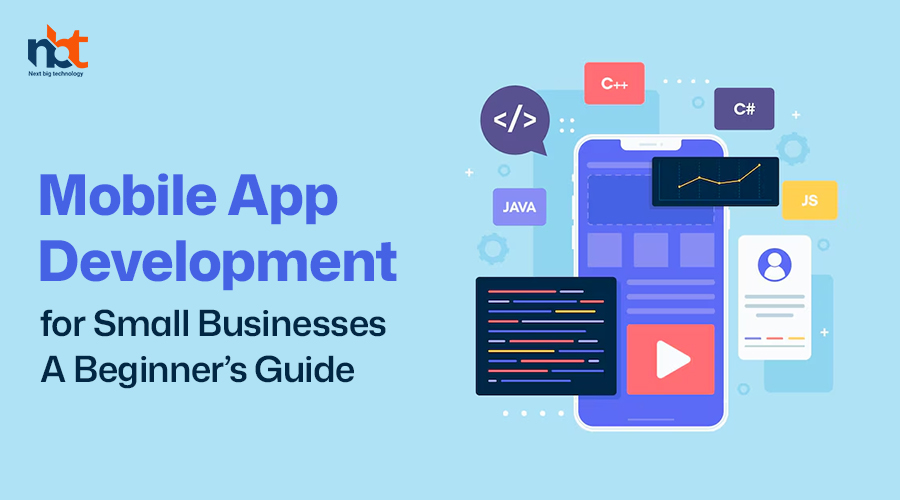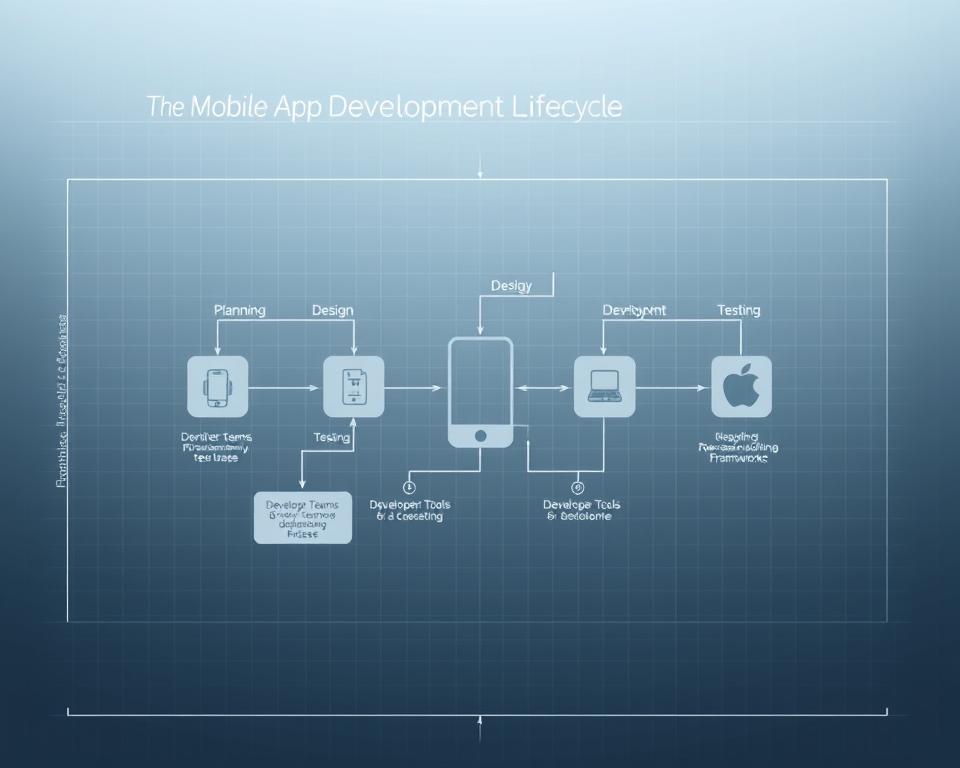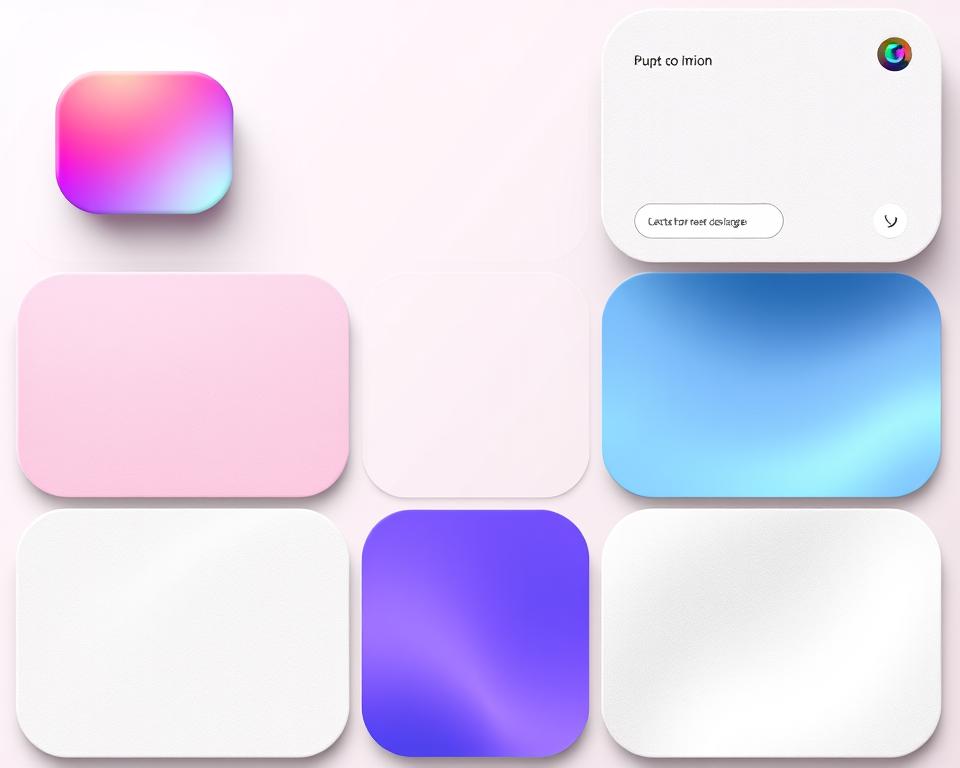In today’s digital world, a mobile app can really help small businesses. It boosts customer interaction and creates new ways to grow and earn money.
Starting out in mobile app development can feel overwhelming. But, with the right help, small businesses can make useful apps that fit their needs and goals.
This guide will help you understand android app development for small businesses. It gives you the key insights and tools you need to do well.
Table of Contents
Key Takeaways
- Understanding the importance of mobile apps for small businesses
- Identifying the right type of app for your business needs
- Learning the basics of application development companies
- Discovering the benefits of having a mobile app
- Exploring the various development options available
Why Your Small Business Needs a Mobile App
The modern consumer loves mobile devices, making it key for small businesses to have a mobile app. It’s important to understand the mobile world and how it changes how people shop.
The Mobile-First Consumer Landscape
Mobile devices have changed how we interact with businesses. Let’s look at some key stats and what consumers expect.
Current Mobile Usage Statistics
Mobile devices are now the main way we access the internet and talk to businesses. Over 70% of digital media time is spent on mobile devices. This shows a big change in how we interact with brands.
| Category | Statistic |
|---|---|
| Mobile Internet Users | Over 70% of digital media time |
| Mobile Commerce | Expected to reach 44.4% of total US retail e-commerce sales |
| App Downloads | Over 218 billion downloads worldwide in 2021 |
Consumer Expectations for Business Accessibility
Now, people expect businesses to be easy to reach and work well on all devices. A mobile app can make customers happier by being easy to use.
Competitive Advantages of Having a Business App
A mobile app can give small businesses a big edge. It offers a direct way to market and boosts brand recognition.
Direct Marketing Channel Benefits
A mobile app is a direct marketing channel to customers. Businesses can send special messages, offers, and updates right to customers’ phones.
Building Brand Recognition and Loyalty
By offering a great experience, businesses can build loyalty and get repeat customers. A well-made app can really help make your brand stand out.
ROI Potential for Small Business Apps
The return on investment (ROI) for small business apps can be huge. Let’s look at some success stories and typical return times.
Success Stories from Small Businesses
Many small businesses have seen big gains from their apps. For example, a local store saw a 25% increase in sales after getting their app.
Typical Return Timelines
While ROI times vary, many see returns in 6 to 12 months after launching their app.
Understanding the Different Types of Mobile Apps
Mobile apps come in several types, each with its own strengths. You have native apps, web apps, hybrid apps, and progressive web apps (PWAs). Knowing these types helps small businesses choose the right app for their needs.
Native Apps vs. Web Apps vs. Hybrid Apps
Native apps are made for one mobile system, like iOS or Android. They work well and feel natural. Web apps, however, are accessed through a browser and don’t get installed. Hybrid apps mix native and web app features, aiming for a balance.
Performance Differences
Native apps usually perform better than web and hybrid apps. They’re made for specific platforms. Web apps can be slower because of browser limits. Hybrid apps are in the middle.
Development Complexity Comparison
Developing native apps is complex because it needs specific skills for each platform. Web apps are simpler, using common web tech. Hybrid apps are in between, combining native and web tech.
Progressive Web Apps (PWAs)
PWAs are a new type that combines web and native app features. They give a native app-like experience in a browser, with offline support and push notifications.
Benefits for Small Businesses
PWAs are great for small businesses because they’re cheaper to make and maintain. They can be used on any device through a browser.
Implementation Requirements
To make a PWA, focus on responsive design, fast loading, and secure connections (HTTPS). Adding features like home screen installation and push notifications can improve user interaction.
Choosing the Right Type for Your Business Needs
Choosing the right app type depends on several factors. Consider your industry, budget, and how fast you need it.
Industry-Specific Considerations
Different industries have different needs. E-commerce might prefer native apps for their speed. Content-based businesses might like PWAs for easy updates and wide reach.
Budget and Timeline Factors
Cost and time are key. Native apps need more resources and time. PWAs are often cheaper and quicker to develop.
| App Type | Performance | Development Complexity | Cost |
|---|---|---|---|
| Native Apps | High | High | High |
| Web Apps | Variable | Low | Low |
| Hybrid Apps | Medium | Medium | Medium |
| PWAs | High | Medium | Low-Medium |
Setting Clear Goals for Your Mobile App
To make sure your mobile app reaches its full potential, setting clear goals is key. This step guides the app’s development and measures its success.
Defining Your App’s Purpose and Value Proposition
Your app’s purpose and value are its foundation. They explain why it exists and what benefits it offers to users.
Problem-Solution Framework
A problem-solution framework helps you see what your app solves. It’s about knowing the challenges users face and how your app can help.
Unique Selling Points
Finding your app’s unique selling points (USPs) is important. USPs make your app stand out and attract more users.
Identifying Your Target Audience
Knowing who your app is for is crucial. It helps you create an app that meets their needs.
Creating User Personas
User personas help you picture your ideal users. They include details like demographics, preferences, and behavior.
Researching User Needs
To understand user needs, you can use surveys, interviews, and usability tests. This data helps make your app user-friendly.
Establishing Key Performance Indicators (KPIs)
KPIs are measurable ways to check if your app is doing well.
Engagement Metrics
Engagement metrics, like daily active users and session length, show how users interact with your app.
Business Impact Metrics
Business impact metrics, like revenue and customer acquisition costs, show your app’s financial success and business impact.
| KPI | Description | Example |
|---|---|---|
| Daily Active Users (DAU) | Number of users who engage with the app daily | 1,000 |
| Session Length | Average time spent using the app per session | 5 minutes |
| Revenue | Total income generated from the app | $10,000 |
Mobile App Development for Small Businesses: A Beginner’s Guide
More and more small businesses are turning to app development as mobile use grows. Building a mobile app can seem daunting, but knowing the steps involved makes it easier.
The App Development Lifecycle
The app development process has several stages: planning, design, development, testing, and deployment. Each stage is vital for the app’s success.
Planning and Research Phase
The first step is detailed planning and research. You need to define the app’s purpose, know your audience, and study competitors. Market research helps you understand what users want.
Design and Development Phase
After planning, it’s time to design and build the app. This includes making wireframes, designing the UI, and coding. Agile development methodologies help with quick changes and updates.
Testing and Deployment Phase
Before launch, the app must be tested for bugs and functionality. Testing includes alpha and beta stages, followed by app store deployment. App store optimization (ASO) boosts visibility.
Essential Resources and Skills Required
Creating a successful app needs technical, design, and project management skills.
Technical Skills Needed
You need to know programming languages like Java, Swift, or Kotlin. Knowing cross-platform development frameworks like React Native or Flutter is also helpful.
Design and User Experience Skills
Design skills are key for a user-friendly interface. Understanding user experience (UX) principles ensures the app meets user needs.
Realistic Timelines for Small Business App Development
Knowing the app development timeline is important for planning and setting expectations.
Milestone Planning
Breaking the development into milestones helps track progress and stay on schedule. Important milestones include design completion, core feature development, and testing.
Common Timeline Challenges
Challenges like scope creep, technical issues, and market changes can affect timelines. Effective project management helps manage these risks.
By understanding the app development lifecycle, resources, and timelines, small businesses can better manage the app development process.
DIY vs. Professional Development: Weighing Your Options
Creating a mobile app for your small business is a big decision. You have to choose between no-code platforms, freelance developers, or a professional app development agency. Each choice has its own advantages and disadvantages.
No-Code and Low-Code Development Platforms
No-code and low-code platforms are popular among small businesses. They are easy to use and don’t cost a lot. These platforms let users make apps without needing to know how to code.
Popular Platforms for Small Businesses
- Appy Pie
- BuildFire
- GoodBarber
These platforms have drag-and-drop tools and templates. They make app development simple. But, they might not let you customize as much as you want, and scaling can be hard.
Limitations and Considerations
No-code platforms are tempting, but they have limits. They might not offer the customization you need. Also, adding complex features can be tough.
| Platform | Cost | Customization |
|---|---|---|
| Appy Pie | $18/month | Limited |
| BuildFire | $49/month | Moderate |
| GoodBarber | $25/month | Moderate |
Hiring Freelance Developers
Hiring freelance developers is another good option for small businesses. Freelancers can bring specialized skills and flexibility to your project.
Finding and Vetting Qualified Freelancers
To find good freelancers, use platforms like Upwork or Freelancer. It’s important to check their portfolios and references.
“The key to successfully working with freelancers is clear communication and setting realistic expectations.” –
Managing Remote Development Work
Managing remote work needs good project management tools and regular meetings. This keeps the project on track.
Working with App Development Agencies
For businesses needing full app development services, an agency might be the best choice. Agencies offer a wide range of services, from design to maintenance.
Cost-Benefit Analysis
Agencies can be more expensive than other options. But, they bring expertise and a complete approach to app development.
When choosing an agency, look for experience in your industry and positive reviews. A strong portfolio is also important.
In conclusion, the decision between DIY, freelance developers, and agencies depends on your business needs and budget. Weighing the pros and cons helps you make a choice that fits your goals.
Budgeting for Your App Project
Before starting your mobile app project, setting a realistic budget is key. You need to know all the costs involved in making and keeping your app up and running.
Understanding the True Cost of App Development
The cost to make a mobile app can change a lot. This depends on the app’s type, how complex it is, and the tech used.
Development Cost Breakdown
There are several costs to consider. Design costs can be from $5,000 to $20,000. Development costs can go from $20,000 to $100,000 or more, based on the app’s complexity.
Regional Cost Variations
Costs also change based on where you are. Hiring developers in North America or Western Europe is pricier than in Eastern Europe or Asia.
Hidden Expenses to Anticipate
There are costs you might not see coming.
Ongoing Maintenance Costs
Keeping your app updated and safe is key. This costs 15% to 20% of the initial cost each year.
Server and Infrastructure Expenses
If your app needs a backend, you’ll have server costs. These depend on your user base and data storage needs.
Funding Options for Small Business App Development
Small businesses have many ways to fund their app development.
Self-Funding Strategies
Using your own money or revenue is a common choice. It lets you keep control over your project.
Small Business Loans and Grants
There are government and private loans and grants for small businesses. They help with app development costs.
Designing Your App for Maximum User Engagement
To make a mobile app that users love, small businesses need to focus on user experience and design. A good app not only draws users in but keeps them coming back. This builds loyalty and helps the business grow.
User Experience (UX) Fundamentals
User experience is key to a successful app. It covers how users interact, navigate, and feel about the app.
Information Architecture
Information architecture is about organizing content in the app. A clear structure helps users find what they need easily.
User Flow Optimization
Improving user flow means making it easier for users to get what they want. This boosts satisfaction and keeps users engaged.
Creating an Intuitive User Interface (UI)
The UI is what users see and interact with. A good UI makes the app fun and easy to use.
Design Principles for Mobile
Designing for mobile means thinking about screen size, touch, and mobile behaviors. Simple and responsive design is essential.
Color and Typography Best Practices
Choosing the right colors and fonts makes the app look good and work well. Keeping things consistent is key for a smooth user experience.
Accessibility Considerations
Making sure the app is accessible to all is a legal and moral must. It’s about making the app for everyone.
ADA Compliance Guidelines
Following ADA guidelines ensures the app is for everyone. This includes those with visual, auditory, or motor disabilities.
Inclusive Design Approaches
Inclusive design means thinking about all users from the start. It aims to make the app usable by as many people as possible.
| Design Element | Description | Best Practice |
|---|---|---|
| Color Scheme | Selection of colors used in the app | Use contrasting colors for readability |
| Typography | Fonts used in the app | Choose clear, legible fonts |
| Navigation | How users move through the app | Simplify navigation paths |
Essential Features for Small Business Apps
Small businesses need to think about what features to include in their mobile app. A good app can really help with customer interaction and loyalty.
Must-Have Functionality for Different Business Types
The features you need depend on your business type. Retail and e-commerce businesses need different things than service-based ones.
Retail and E-commerce Features
- Product catalog with filtering and sorting options
- Secure payment gateway
- Order tracking and history
- Personalized recommendations
Service Business Features
- Appointment scheduling
- Service descriptions and pricing
- Professional profiles
- Customer review system
Integration with Existing Business Systems
It’s important to integrate your app with your current systems. This makes for a better customer experience.
CRM and Customer Management
Connecting your app to CRM systems helps manage customers better. It also makes marketing more personal.
Payment Processing Solutions
Secure payment processing is key for any business. Using reliable payment gateways makes transactions smooth.
| Integration Type | Benefits | Examples |
|---|---|---|
| CRM Integration | Enhanced customer management, personalized marketing | Salesforce, HubSpot |
| Payment Gateway | Secure transactions, ease of payment | Stripe, PayPal |
Security Features to Protect User Data
Security is crucial when making a mobile app. Keeping user data safe is not just legal, but also builds trust.
Data Encryption Methods
Strong encryption like SSL/TLS and AES keeps user data safe.
Secure Authentication Options
Using biometric authentication and two-factor authentication adds more security.
Choosing the Right Platform: iOS vs. Android vs. Cross-Platform
When you’re making a mobile app for your small business, picking the right platform is key. This choice affects how many people can use your app, how much it costs to make, and how well it does.
Platform Demographics and User Behavior
It’s important to know who uses each platform. iOS and Android have different users with their own likes and habits.
iOS User Characteristics
iOS users are often rich and like to spend money on apps. They use their phones a lot, spending hours each day.
Android User Characteristics
Android users come from all over the world. They use a wide range of devices, which can be both good and bad.
Development Costs Across Platforms
How much it costs to make an app changes a lot depending on the platform. Development costs depend on how complex the app is, the tech used, and the team needed.
Single Platform Development Economics
Going for one platform can save money at first but might limit your app’s reach. Think about the pros and cons of this choice.
Multi-Platform Development Economics
Building for both iOS and Android at once costs more upfront but lets more people use your app. Cross-platform development tools can help lower these costs.
Cross-Platform Development Tools and Frameworks
With cross-platform development, you can make your app work on both iOS and Android from one codebase. React Native and Flutter are popular for making this easier.
React Native Capabilities
React Native lets developers make native apps with JavaScript and React. It’s known for its hot-reloading feature and big community support.
Flutter Advantages
Flutter uses Dart and is fast and easy to use. It’s great for making apps look good and work well.
In the end, choosing between iOS, Android, or cross-platform depends on your goals, who you want to reach, and your resources. Think carefully about these things to make the best choice.
Testing Your App Before Launch
Before you launch your mobile app, it’s vital to test it thoroughly. A well-tested app makes users happy and keeps your brand’s reputation strong.
Types of Testing Required
Several types of testing are needed to get your app ready for launch. You’ll need to test if all features work right, how fast the app is, and how it handles heavy use.
Functional Testing Approaches
Functional testing checks if each app feature works as it should. This includes testing the app’s interface, APIs, and databases. It’s important to test both good and bad scenarios to cover all user interactions.
Performance and Stress Testing
Performance testing checks how fast and stable your app is. Stress testing pushes the app to its limits to see how it handles extreme loads.
Beta Testing with Real Users
Beta testing lets you release your app to a small group to get feedback and find bugs missed in initial tests.
Recruiting Beta Testers
To find beta testers, you can ask your current users, use social media, or beta testing platforms. The goal is to get real users’ feedback.
Collecting and Analyzing Feedback
Once you have beta testers, it’s important to collect their feedback carefully. This means looking at bug reports, user comments, and other data to find areas to improve.
Addressing Feedback and Fixing Bugs
After getting feedback, you need to fix the issues raised by beta testers. This means sorting bugs by how serious they are and fixing the most important ones first.
Prioritizing Issues
Sorting bugs by importance is crucial. This way, you fix the most critical issues first. It helps ensure the app works well for users.
Quality Assurance Processes
Quality assurance (QA) processes are key to making sure your app meets standards. This includes testing, monitoring, and always looking for ways to improve.
Launching Your App Successfully
Launching your mobile app needs a smart plan. This includes optimizing your app store listing and using good marketing. A well-thought-out launch is key for your app’s success, especially for small businesses.
App Store Optimization Strategies
App Store Optimization (ASO) boosts your app’s visibility. It means making your app’s title, description, and keywords match what users search for.
Keyword Research and Implementation
Do deep keyword research to find terms your audience uses. Use these keywords in your app’s title, description, and metadata.
Rating and Review Management
Get users to leave ratings and reviews as they help your app’s visibility and trustworthiness. Reply quickly to all reviews to show you care about user happiness.
Creating a Compelling App Store Listing
Your app store listing is your app’s first impression. Make it impactful by writing a clear, concise, and engaging listing.
Screenshot and Video Best Practices
Use top-notch screenshots and videos to highlight your app’s features and design. Make sure they work well on all devices and orientations.
Writing Effective App Descriptions
Your app description should clearly state its value, features, and benefits. Use simple and direct language to grab potential users’ interest.
Launch Marketing Tactics for Small Businesses
Good launch marketing is essential for getting people excited about your app. Use both pre-launch and post-launch plans to reach more people.
Pre-launch Promotion Strategies
Get people excited with pre-launch promotions like teasers on social media, email, and influencer partnerships.
Post-launch Marketing Activities
Keep engaging your audience with post-launch marketing like content, social media, and ads.
By focusing on ASO, a great app store listing, and smart launch marketing, you can boost your app’s success in a busy market.
Maintaining and Updating Your App
To keep your app relevant and functional, regular updates and maintenance are key. This ongoing process ensures your app meets user needs and stays competitive.
Ongoing Maintenance Requirements
Regular maintenance is crucial for addressing technical issues and adapting to changes in operating systems.
Technical Debt Management
Managing technical debt involves prioritizing and addressing outstanding technical issues to prevent them from becoming major problems.
Operating System Updates
Staying updated with the latest OS versions is vital to ensure compatibility and security.
Planning for Updates and New Features
Strategic planning is necessary for deciding on updates and new features.
Feature Prioritization Framework
Using a prioritization framework helps in identifying which features to develop or update based on user needs and business goals.
Version Release Planning
Planning the release of new versions involves scheduling, testing, and deployment to ensure a smooth rollout.
| Maintenance Task | Frequency | Importance |
|---|---|---|
| Technical Debt Management | Quarterly | High |
| OS Updates | As Needed | High |
| Feature Updates | Bi-Annually | Medium |
Managing User Feedback and Support
Effectively managing user feedback and providing support are critical for user satisfaction.
Support Channel Options
Offering multiple support channels, such as email, chat, and FAQs, helps in addressing user queries efficiently.
Implementing User Suggestions
Analyzing and implementing user suggestions can significantly enhance user experience and app functionality.
Future Trends in Mobile App Development
Looking ahead, several trends are shaping mobile app development. These trends come from new technologies and how users behave. The future of mobile apps is about adapting to new tech and understanding user needs.
Emerging Technologies for Small Business Apps
Emerging technologies are key in changing mobile app development. Two big technologies are making a big impact:
Artificial Intelligence Integration
Artificial Intelligence (AI) is being used more in mobile apps. It makes apps better by personalizing experiences, predicting what users want, and automating tasks. For example, AI chatbots in customer service apps offer instant support and boost user interaction.
Augmented Reality Applications
Augmented Reality (AR) is also becoming popular in apps, especially in retail and gaming. AR adds digital info to the real world, giving users immersive experiences.
Changing User Expectations
User expectations are changing fast, thanks to mobile devices. Two areas where expectations are shifting are:
Privacy-First Development
Users now want apps to be more secure and clear about data use. Developers are focusing on privacy-first development. This means protecting user data and following rules like GDPR.
Personalization Demands
Users also want more personalized app experiences. This means using data and AI to offer tailored content and suggestions that fit each user’s needs.
Preparing Your Business for Mobile Evolution
To stay ahead in the mobile world, businesses must be proactive. Two ways to prepare your business are:
Scalable Architecture Planning
Investing in scalable architecture is key for future-proofing your app. This means designing your app to grow with new tech and user needs without needing a full rebuild.
Future-Proofing Strategies
Businesses should also focus on future-proofing. This includes keeping up with new tech and trends, and being ready to innovate and adapt quickly to user and market changes.
Conclusion
Developing a mobile app can change the game for small businesses. It helps them reach more people and engage with customers better. By knowing the different types of apps and setting clear goals, small businesses can use mobile tech to grow.
A good mobile app can make customers happier, make things easier, and give you an edge over others. As mobile app development keeps changing, it’s key for small businesses to keep up. This way, they can stay ahead in the game.
In short, investing in mobile app development is smart for small businesses. It helps them succeed in a world where mobile is everything. By using the tips from this guide, businesses can make smart choices and do well in the mobile app world.



















